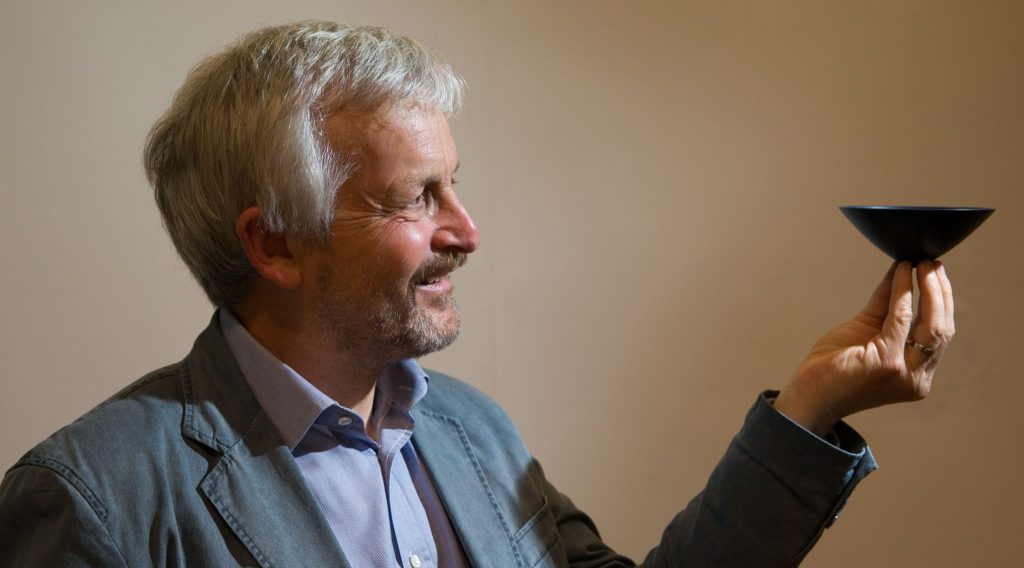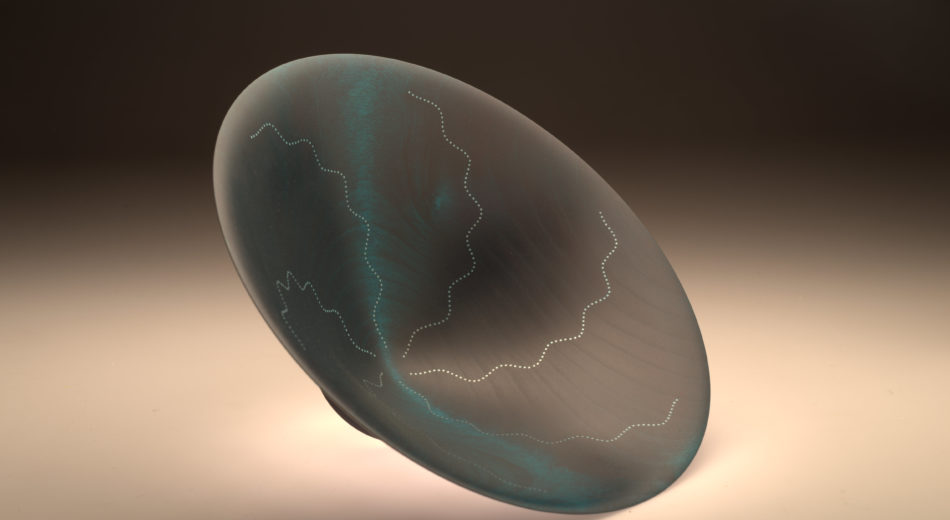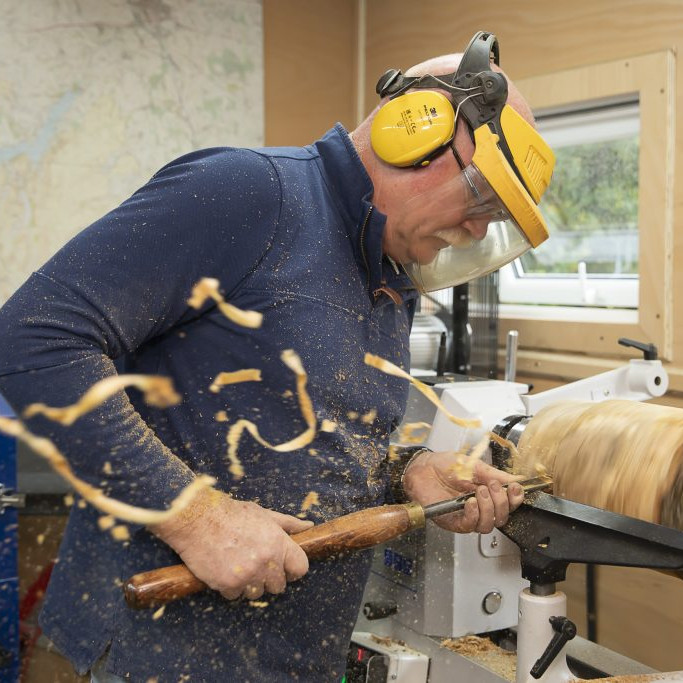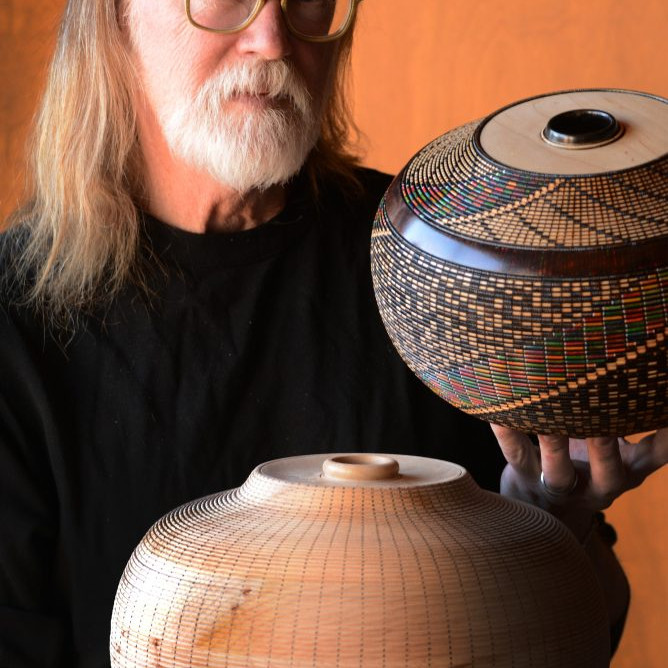Roger Bennett Wood Artist - Dublin,Ireland
Discuss the use of colour in your work.
I colour my work with water-based wood dyes, and I finish with three applications of Danish oil which protects the colour and gives the surface a gentle sheen.
I love using water-based dyes: they work with the wood, highlighting and enhancing the natural figuring and grain patterns. A very bland piece of wood can come alive when the dye is applied, as different areas of the wood respond with subtly varied hues.

When did you decide to make your bowls coloured? And what led you to this decision?
A lot of my inspiration comes from ceramics: shapes, proportions, rims and bases, surface finishes… Lucie Rie is my all-time hero, and I love the work of ceramists such as Jennifer Lee, Sara Flynn, Pippin Drysdale. So for me the decision to start colouring my work was entirely natural.
Soon after I started turning, I saw the British woodturner Paul Clare demonstrate his colouring methods: that was a good technical introduction, and I immediately started experimenting.
Explain the stability of your bowls.
My bowls are usually very thin-walled and light. I like to accentuate this sense of delicacy by giving them small bases, so that they can seem almost as if they are floating, or kissing the surface beneath them. I am obsessed with clean lines and with level, regular rims, therefore in my work the stability of the wood is paramount.
To ensure this stability, I follow standard bowl-making practice. I first rough-turn each bowl from unseasoned wood, leaving the walls thicker than in the final piece, and then I weigh it, and air dry it indoors at room temperature. As it dries and loses moisture, the weight decreases; I weigh it at weekly intervals, and when it stops losing weight it is ready to finish.
The drying process distorts the bowl – it shrinks across the grain, becoming oval and boat-shaped, so when I remount it on the lathe I must turn off this distortion as I bring it down to the final profile and wall thickness.
Why do you favour sycamore?
Sycamore – acer pseudoplatanus – is my favourite wood. It is a perfect canvas for colouring: in appearance, it is pale, often quite bland; it is fine-grained, and is a forgiving wood, capable of accepting a lot of abuse without splitting. It is readily available, as it grows like a weed in Ireland!
I do occasionally use other woods, e.g. cherry, hornbeam, beech.
Can you expand on how you inlay gold and silver into your work? Explain how this is achieved and the patterns you use.
I inlay a lot of my pieces with dots of silver, and occasionally gold. To do this, I drill hundreds of little holes (0.5 – 0.9 mm in diameter) into – but not through – the wood, and carefully glue in short lengths of wire, holding the wire tightly in a pair of pliers. Then I snip off the protruding bits, and sand the metal flush with the wood. This is very careful, painstaking work – one mistake, and I have rather expensive firewood!
I draw many of my designs on computer with vector graphic editing and design software (CorelDRAW), then print out the templates. I like to create patterns which have an organic relationship with the shape of the bowl: for example, lines which radiate out from the centre like the spokes of a wheel, or which arc from the centre to the rim as if they have been curved by the spinning bowl’s centrifugal motion.
I love spirals, the latent energy of a coiled spring contained within the bowl. I also love creating ‘controlled random’ patterns: hundreds of dots positioned freehand – but carefully – which suggest constellations of stars in a night sky.
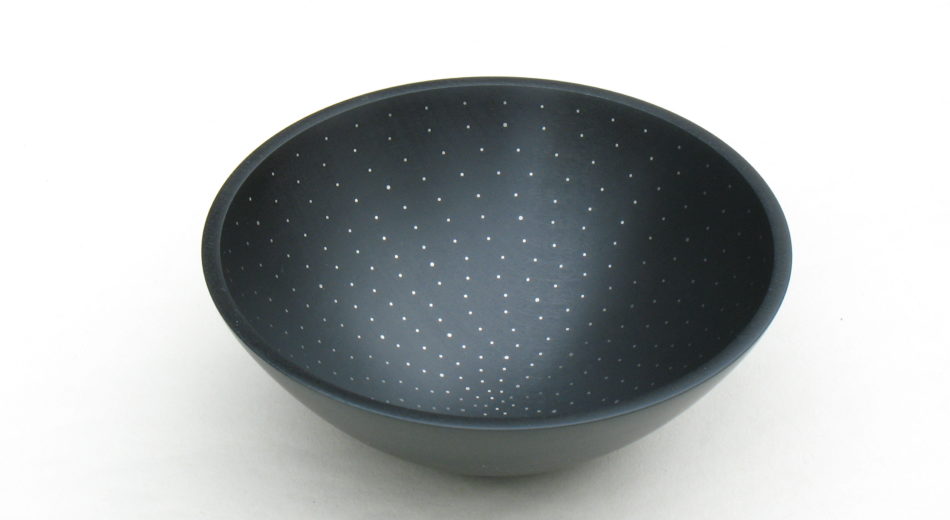 Coloured sycamore with controlled random pattern of silver inlay
Coloured sycamore with controlled random pattern of silver inlay
What led you to wood turning?
In my previous life I was a teacher of English and French. In 1992 when I was on a career break, I saw a woodturning demonstration quite by chance. I was immediately transfixed, like a toddler on his first visit to the zoo! I had to try this! So I signed up for evening classes with a retired woodworker. The first piece I made was an eggcup, which I kept on my bedside table so that I would see it first thing in the morning.
I put up a little workshop behind our house, bought a lathe and some basic tools, and my life changed forever.
When and how did you take it to the next level – as a professional?
My career break was supposed to be for one year, but my employers kindly allowed me to extend it. I turned day and night, and I started selling my work, at first in a weekend market, then through shops and galleries.
In 1994-5 I got accepted onto a Crafts Council design and business course in Kilkenny, and this was crucial to my development. For that year, I was provided with a workspace and a living allowance, I had a business mentor, and there were very practical sessions on essential business skills such as marketing, book-keeping, pricing, product development. After all that, I just couldn’t go back to my teaching career!

Coloured sycamore with spiral of gold dots
Discuss your feelings, when you learnt that Mary MacAleese (President of Ireland) had your work?
It is always thrilling to learn that a piece has been presented to somebody well known, especially to somebody so universally admired as President MacAleese. She herself told me when I met her at a reception a few years ago that she had recently given one of my bowls to the President of Latvia.
The National Museum of Ireland has four of my bowls in its permanent collection, and I have pieces in other museums such as the Museum of Fine Arts in Boston and the Honolulu Museum of Art. We makers can be prey to feelings of doubt, so this sort of purchase or acquisition is always a welcome boost to our sense of self-worth.
Discuss your text, ‘I love wood …’
I was trying to write an artist’s statement to put on my website, one which would capture and convey the essence of what and why and how I create and would express my dreams and aspirations. Woodturning is very physical, very tactile, but it can also be intensely spiritual. It is almost beyond words, the thrilling sensation of holding, touching, and caressing a bowl or vessel which is ‘right’, whether it be wood, ceramic, glass, metal…
I love wood, the uniqueness of each piece, the history of the tree preserved in the ring patterns and figuring. I delight in the daily interaction between maker and material, the magic of shaping, turning an argument into a conversation.
I dream of making a bowl as strong as an eggshell, as heavy as a whisper. Of capturing and fixing my favourite colours – drake mallard green, oil on water, midnight in midsummer, frosty night skies.
And with silver, I can indulge my love of order, impose my markings on the wood’s surface, complement the natural flows and eddies of the grain with my precise patterns of dots.
A completed bowl should satisfy all our senses.
Line and form above all else, traced by eye and hand from rim to base and all around.
The smell of wood and oil.
And when a bowl is right, it sings.
I enjoy writing: I am a member of a craft writers group, and co-editor of a marvellous online journal makebelieve.ie. I also write occasional articles and essays, mostly for woodturning and ceramics magazines; there are links to these from my website.
Discuss your thoughts on the promotion of woodturning within the current art scene.
I suppose woodturning can be seen as the Cinderella of the applied arts. It is an ancient craft, dating from at least the 6th century B.C., but artistic woodturning really only developed in the second half of the 20th century.
Is it being well promoted? Yes and no. The work of the leading turners such as David Ellsworth, Richard Raffan, Benoît Averly, Liam Flynn, is of astonishing quality and beauty, and more and more it is being noticed and written about and collected and exhibited. However, I think woodturning does still lag behind ceramics and glass, for example, in the perceived hierarchy of applied arts. But give it time…
 You also make wooden jewellery. Take one or two pieces and discuss them.
You also make wooden jewellery. Take one or two pieces and discuss them.
I started to make jewellery a few years ago. People often remarked to me at craft events that they would love to be able to wear one of my little bowls! In my jewellery range – pendants, earrings, cufflinks – I use colouring and inlaying techniques similar to those in my bowl-making. The Crafts Council gave me very welcome support, a funding grant to work on some of the technical issues with a brilliant jeweller, Erika Marks.

This is an early drop pendant on a silver choker, dyed sycamore inlaid with silver dots of two diameters.

My disc-shaped pendants gave me a new and interesting challenge: designing for a flat rather than a curved surface. These are turned from ebony: I love the strong black/silver contrast
Your wall pieces, discuss.
One thing led to another: my wall pieces evolved from the designs of my disc pendants. Again, customers’ feedback helped to spark me into making these – I was told that everybody has some available wall space, but not necessarily shelf or table space, for display purposes.
Size (constrictions)
While my wall pieces are bigger than most of my bowls, the diameter is determined by the size of my lathe: I can’t go beyond 50 cm.
When you use a frame effect or not on a piece
As with my pendants, I sometimes encircle the smooth centre with a darker, textured rim; sometimes I leave the disc unframed.
The amount of silver used
For the silver to make an impact on such a relatively big surface, I need to use a lot of it – often thousands of dots. It is very concentrated work; I wear a jeweller’s magnifier, and take lots of breaks!
How are they hung?
The wall-pieces are hung on a cord, looped between two specially designed cast silver bails glued to the back.
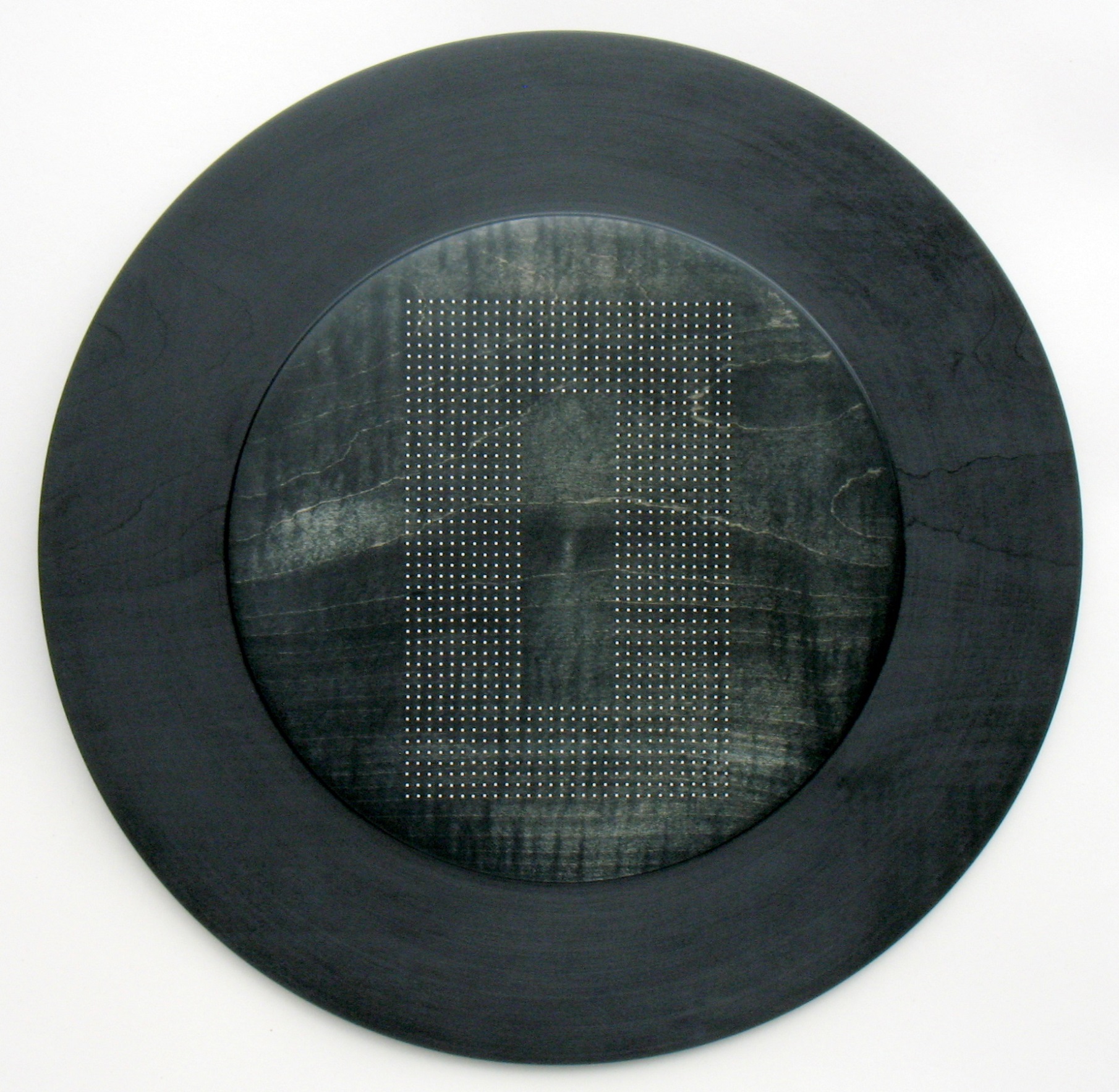
Coloured sycamore wall piece with hollow rectangle of siver dots
Do you exhibit them in groups or always singularly?
So far, I have only made individual pieces, but a group or series is a very interesting idea which I would like to explore.
Explain the role of RDS Craft Awards to your craft and other crafts.
The Royal Dublin Society was founded in 1731. It is a philanthropic organisation whose mission is “to see Ireland thrive culturally and economically … by working across five disciplines: science, the arts, agriculture, business and equestrianism”. The annual RDS Craft Awards exhibition is a significant and prestigious event, with a prize fund of €30,000.
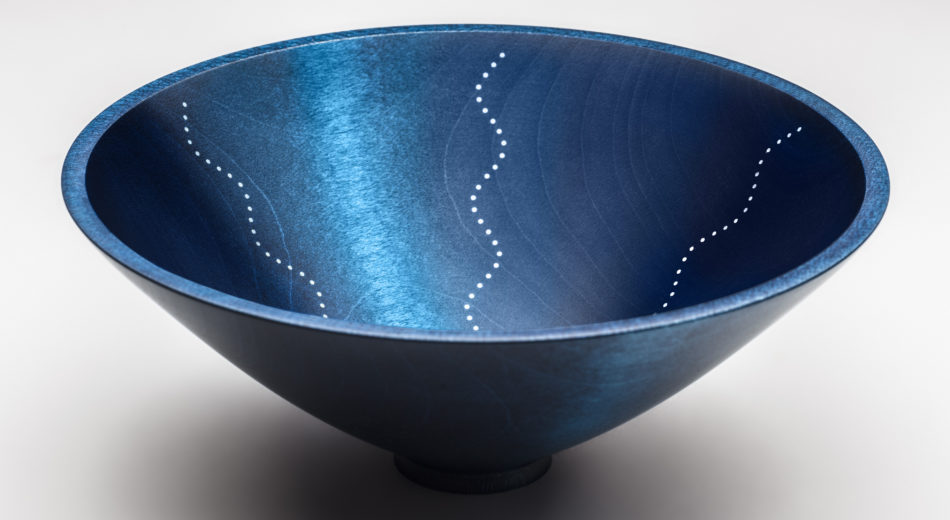
RDS Craft award-winning bowl
I was delighted to receive the 2016 Established Maker Award for one of my coloured and inlaid sycamore bowls, and to be part of a travelling exhibition with other prizewinners across a broad range of disciplines from basketry to silversmithing. Such awards give an invaluable lift to the profile and reputation of the winners. I recently took part in a big craft fair in Dublin, and I was amazed by the number of visitors who told me that they had seen my little prize-winning bowl.
Contact details
Roger Bennett
Email: parkbenn@gmail.com
www.rogerbennettwoodturner.com
Roger Bennett, Dublin, Ireland
Interview by Deborah Blakeley, February 2017
Think a colleague or friend could benefit from this interview?
Knowledge is one of the biggest assets in any business. So why not forward this on to your friends and colleagues so they too can start taking advantage of the insightful information the artist has given?
Other artists you may be interested in:


